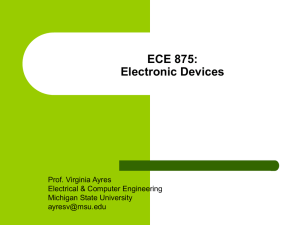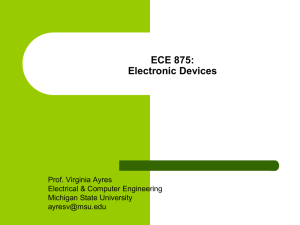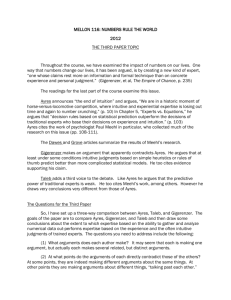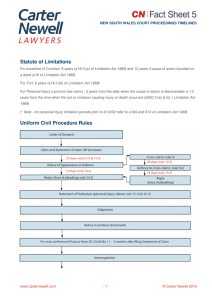Lecture 08, 27 Jan 14 - Michigan State University
advertisement
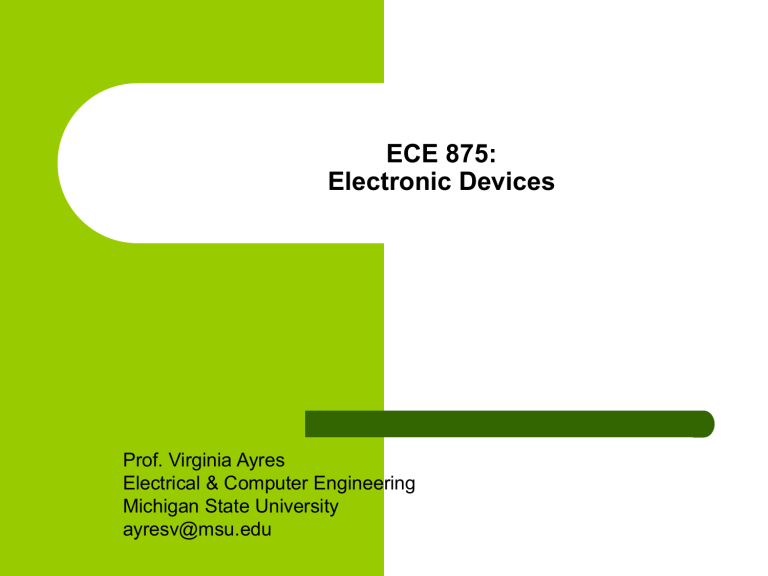
ECE 875: Electronic Devices Prof. Virginia Ayres Electrical & Computer Engineering Michigan State University ayresv@msu.edu Lecture 08, 27 Jan 14 Chp. 01 Concentrations Degenerate Nondegenerate Contributed by traps } Effect of temperature VM Ayres, ECE875, S14 Example: Concentration of conduction band electrons for a nondegenerate semiconductor: n: 3D: Eq’n (14) n “hot” approximation of Eq’n (16) EC E N E F E dE EC Three different variables (NEVER ignore this) VM Ayres, ECE875, S14 Answer: Concentration of conduction band electrons for a nondegenerate semiconductor: n: mde 3 2 2M C 2 3 mde MC NC The effective density of states at the conduction band edge. VM Ayres, ECE875, S14 Answer: Concentration of conduction band electrons for a nondegenerate semiconductor: n: E F EC n N C exp kT Nondegenerate: EC is above EF: EC E F n N C exp kT Sze eq’n (21) NC EC E F kT ln n Use Appendix G at 300K for NC and n ≈ ND when fully ionised VM Ayres, ECE875, S14 Lecture 07: Would get a similar result for holes: This part is called NV: the effective density of states at the valence band edge. Typically valence bands are symmetric about G: MV = 1 VM Ayres, ECE875, S14 Similar result for holes: Concentration of valence band holes for a nondegenerate semiconductor: p: EV EF p NV exp kT Nondegenerate: EC is above EF: EF EV p NV exp kT Sze eq’n (23) NV EF EV kT ln p Use Appendix G at 300K for NV and p ≈ NA when fully ionised VM Ayres, ECE875, S14 HW03: Pr 1.10: Shown: kinetic energies of e- in minimum energy parabolas: KE E > EC. Therefore: generic definition of KE as: KE = E - EC VM Ayres, ECE875, S14 HW03: Pr 1.10: EC E E E dn( E ) C Define: Average Kinetic Energy EC EC E dnE EC Single band assumption VM Ayres, ECE875, S14 HW03: Pr 1.10: “hot” approximation of Eq’n (16) 3D: Eq’n (14) EC E E E N E F E dE C Average Kinetic Energy EC EC E N E F E dE EC Single band assumption VM Ayres, ECE875, S14 HW03: Pr 1.10: “hot” approximation of Eq’n (16) 3D: Eq’n (14) EC E E E N E F E dE C Average Kinetic Energy EC EC E N E F E dE EC Equation 14: N (E) mde 3 2 2M C 2 3 E EC 1/ 2 Single band definition VM Ayres, ECE875, S14 Considerations: mde N (E) 3 2 2M C 2 3 E EC 1/ 2 VM Ayres, ECE875, S14 Therefore: Single band assumption: means: VM Ayres, ECE875, S14 Therefore: Use a Single band assumption in HW03: Pr 1.10: “hot” approximation of Eq’n (16) 3D: Eq’n (14) EC E E E N E F E dE C Start: Average Kinetic Energy EC EC E N E F E dE EC Finish: Average Kinetic Energy 3 kT 2 VM Ayres, ECE875, S14 Reference: http://en.wikipedia.org/wiki/Gamma_function#Integration_problems Some commonly used gamma functions: n is always a positive whole number VM Ayres, ECE875, S14 Because nondegenerate: used the Hot limit: EC EF Ei EV - = F(E) VM Ayres, ECE875, S14 Consider: as the Hot limit approaches the Cold limit: “within the degenerate limit” EC EF Ei EV Use: VM Ayres, ECE875, S14 Will find: useful universal graph: from n: Dotted: nondegenerate Solid: within the degenerate limit y-axis: Fermi-Dirac integral: good for any semiconductor x-axis: how much energy do e-s need: (EF – EC) versus how much energy can they get: kT VM Ayres, ECE875, S14 Concentration of conduction band electrons for a semiconductor within the degenerate limit: n: 3D: Eq’n (14) n EC E N E F E dE EC Three different variables (NEVER ignore this) VM Ayres, ECE875, S14 Part of strategy: pull all semiconductor-specific info into NC. To get NC: VM Ayres, ECE875, S14 Next: put the integrand into one single variable: VM Ayres, ECE875, S14 Next: put the integrand into one single variable: Therefore have: And have: VM Ayres, ECE875, S14 Next: put the integrand into one single variable: Change dE: Remember to also change the limits to hbottom and htop: VM Ayres, ECE875, S14 Now have: Next: write “Factor” in terms of NC: VM Ayres, ECE875, S14 Write “Factor” in terms of NC: Compare: VM Ayres, ECE875, S14 Write “Factor” in terms of NC: VM Ayres, ECE875, S14 F1/2(hF) No closed form solution but correctly set up for numerical integration VM Ayres, ECE875, S14 Note: hF = (EF - EC)/kT is semiconductor-specific F1/2(hF) is semiconductor-specific But: a plot of F1/2(hF) versus hF is universal Could just as easily write this as F1/2(x) versus x VM Ayres, ECE875, S14 Recall: on Slide 5 for a nondegenerate semiconductor: n: 3D: Eq’n (14) n “hot” approximation of Eq’n (16) EC E N E F E dE EC EC E F n N C exp kT n NC 2 E F EC exp h F exp NC 2 2 kT 2 F1/2(hF) VM Ayres, ECE875, S14 Useful universal graph: Dotted: nondegenerate Solid: within the degenerate limit y-axis: Fermi-Dirac integral: good for any semiconductor x-axis: how much energy do e-s need: (EF – EC) versus how much energy can they get: kT VM Ayres, ECE875, S14 VM Ayres, ECE875, S14 Why useful: one reason: Around -1.0 Starts to diverge -0.35: ECE 874 definition of “within the degenerate limit” Shows where hot limit becomes the “within the degenerate limit” EC EF Ei EV VM Ayres, ECE875, S14 Why useful: another reason: F(hF)1/2 integral is universal: can read numerical solution value off this graph for any semiconductor Example: p.18 Sze: What is the concentration n for any semiconductor when EF coincides with EC? VM Ayres, ECE875, S14 Why useful: another reason: Answer: Degenerate EF = EC => hF = 0 Read off the F1/2(hF) integral value at hF = 0 ≈ 0.6 Appendix G VM Ayres, ECE875, S14 Example: What is the concentration of conduction band electrons for degenerately doped GaAs at room temperature 300K when EF – EC = +0.9 kT? EF 0.9 kT EC Ei EV VM Ayres, ECE875, S14 Answer: VM Ayres, ECE875, S14 For degenerately doped semiconductors (Sze: “degenerate semiconductors”): the relative Fermi level is given by the following approximate expressions: VM Ayres, ECE875, S14 Compare: Sze eq’ns (21) and (23): for nondegenerate: Compare with degenerate: VM Ayres, ECE875, S14 Lecture 08, 27 Jan 14 Chp. 01 Concentrations Degenerate Nondegenerate Contributed by traps } Effect of temperature VM Ayres, ECE875, S14 Nondegenerate: will show: this is the Temperature dependence of intrinsic concentrations ni = pi ECE 474 VM Ayres, ECE875, S14 Correct definition of intrinsic: Intrinsic: n = p Intrinsic: EF =Ei = Egap/2 Set concentration of e- and holes equal: For nondegenerate: = VM Ayres, ECE875, S14 Solve for EF: EF for n = p is given the special name Ei VM Ayres, ECE875, S14 Substitute EF = Ei into expression for n and p. n and p when EF = Ei are given name: intrinsic: ni and pi ni = pi = n i = p i: VM Ayres, ECE875, S14 Substitute EF = Ei into expression for n and p. n and p when EF = Ei are given name: intrinsic: ni and pi ni = pi = Units of 4.9 x 1015 = ? = cm-3 K-3/2 n i = p i: VM Ayres, ECE875, S14 Plot: ni versus T: ni 1018 Note: temperature is not very low 106 VM Ayres, ECE875, S14 Dotted line is same relationship for ni as in the previous picture. However: this is doped Si: 1017 1013 < liquid N2 When temperature T = high, most electrons in concentration ni come from Si bonds not from dopants VM Ayres, ECE875, S14


